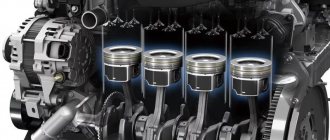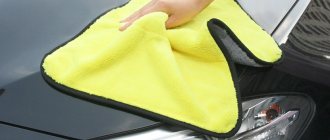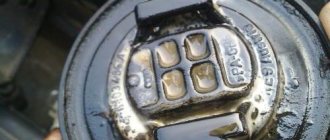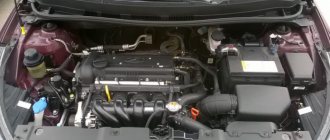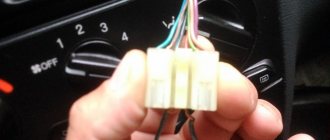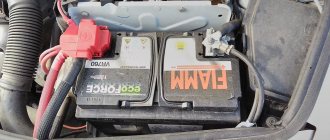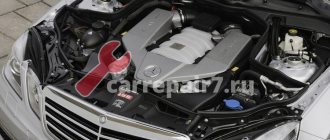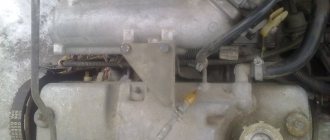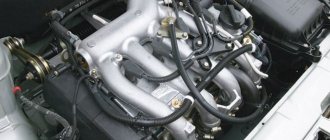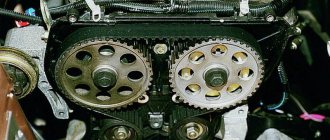Increasingly, car owners decide to undergo such a procedure as washing the engine of their favorite car. It is certainly necessary to clean the power unit, since its condition and durability depend on it. But sometimes after water procedures the engine gives drivers a surprise - the engine stalls or does not start. In order to respond to such a turn of events in a timely manner, it is necessary to understand what actions to take next.
Various problems may occur after washing your car.
Is it necessary to wash the engine?
There are many opinions and rumors regarding this issue. There are always pros and cons, pros and cons. One of the reasons why the engine is washed is heavy leaks of oil, antifreeze, or antifreeze. The biggest cause of this, of course, is the oil sludge on the engine. It interferes with normal cooling in the summer and the engine overheats. To see and then eliminate where the oil is leaking from, it’s a good idea to wash the engine in a car wash with special chemicals and knock it all down under pressure with water. Coolant corrodes contacts, engine harness wires, electronic control unit and other electrical components of the internal combustion engine, which can adversely affect the operation of the engine.
If the car is often driven outside the city, in the forest, or on rough terrain, dirt sticks heavily to the engine, cooling fan, and radiator. If you don’t knock the clay off the fan in time, it will create vibration and simply break the bearing over time, and you’ll have to replace it. And the cost reaches, especially on foreign cars, colossal amounts.
This way, you can be sure that engine washing is necessary in some cases. But doing it just for the sake of prevention, or against dust, makes no sense. After all, the price of such a procedure can result in tens, or even 100 thousand rubles. One of the expensive components in the engine compartment is the electronic engine control unit. Its cost is measured in tens of thousands of rubles, it all depends on the make of the car. The second most expensive part and the most risk of failure is the ignition coil. It's not cheap. Why are these expensive parts listed in the engine compartment? The thing is that when washing the engine, the car starts to misfire, precisely because of them.
Let's take a closer look at the nuances of the car shaking after washing the engine, how to identify the cause of the shaking, eliminate it on site or in a car service center, and how to prevent water from getting on the electrical elements.
see also
Air leak
- 193 9 266k
Troubles a cold engine. A selection of discussions
- 9 0 34k
Knock sensor: device, functions and purpose
- 59 0 55k
Why does the engine stall?
- 10 1 38k
Signs of valve burnout
- 45 5 110k
The question “why does it start in wet weather” is especially relevant with the advent of rainy weather, when it is constantly excessively humid and damp, and quite a lot of car owners are faced with the problem when their car does not start in wet weather . It is especially problematic to start a car after being idle overnight.
As a rule, in the mornings, during a rush, a most unpleasant situation appears: it doesn’t want to start, then it stalls, or even just stalls in damp weather. There is, of course, only one reason – moisture. But where exactly did it get and where did it leak? A visual inspection of the engine compartment is unlikely to reveal any obvious damp spots or defects.
Reasons for car shaking after washing
No spark
Since a high-pressure apparatus is used when washing the engine, the amount of water it produces is enormous. Some of it ends up in spark plug wells on sixteen valve, two shaft or more engines. Car owners, of course, do not suspect this; they start the engine, the coil begins to spark through the water onto the engine ground and immediately closes. If in such a situation you do not turn off the engine and drive further under load, the coil can pierce the primary circuit so much that reverse current flows towards the electronic control unit and burns through the transistor that controls the coil and nearby circuit board tracks. Then the brain cannot be restored; you will have to buy a new one. It's not a cheap purchase and most cars don't have them in stock.
Often, when selling a car, the engine is washed in order to hide oil leaks, or simply for beauty in order to sell it at a higher price. For example, on vases with an eight-valve engine, the ignition coil, which is located opposite the cooling radiator, is immediately filled. It strikes a spark and covers high-voltage wires and spark plugs along the chain. It is rare, but there is a breakdown of the ECU itself, as described above.
Thus, when water gets into the spark plug wells after washing, the engine shakes and the car jerks violently. Until the water is removed from there and the broken parts of the high-voltage circuit are replaced, the motor will operate unstably. After washing the engine, you can leave the car with the hood open for a while and wait until all the parts dry. The best option, of course, would be to blow the engine with air from the compressor.
Action of alkali
Shampoos for washing cars and engines have a powerful alkaline composition that is designed for oil and fat deposits. He washes them off in one go. But when they wash the engine with it, contact also occurs with the plastic of sensors, high-voltage wires, and ignition coils. The composition of the product begins to corrode, especially on older cars, the wiring and short circuits appear, which leads to tripping, and worst of all, when the car does not start.
Mechanical failure
Mechanical damage to engine parts from a high-pressure washer can be an important factor. The connectors of the sensors, electronic control unit, and ignition coils can be damaged.
The most dangerous thing is water entering through the air filter. When starting, it can get into the combustion chamber and a water hammer will occur, but this is a very rare and practically unrealistic case. This can happen, for example, if the air filter is not installed at all.
Elimination of uneven motor operation
Most often, the engine stalls after washing due to water getting into the ignition system. This is where you should start troubleshooting. The following items need to be checked:
- distributor, if present in the ignition system;
- armored wires;
- ignition coil;
- candle wells.
If there is liquid on any of the above elements, it must be removed. When wiping elements, you should visually check their technical condition. There may be situations when, after washing, cracked high-voltage wires or worn-out spark plugs are revealed. If you notice an element that has come out of order, you must replace it without waiting for scheduled maintenance.
It is more difficult to detect water getting inside the cylinders and damage to the sensors. Usually in this case computer diagnostics comes to the rescue. By reading the error log, a specialist can determine why the Check Engine light came on and the engine tripped.
Computer diagnostics
How to fix the situation
If, after washing the engine, it still starts to work, you need to take action. First, dry everything. Remove the high-voltage wires, individual ignition coils from the spark plugs and blow out the wells. Dry all connectors and treat with a water-repellent liquid, such as WD-40. It just has the effect of displacing moisture from the contacts. If you don't have a compressor on hand to blow it out, you'll have to wait with the hood open until it dries on its own.
Tips for restoring the performance of the power plant
If cleaning the engine compartment results in the engine being unable to start, the car owner should not panic and immediately call a tow truck. You can correct the situation right on the spot. It is enough to dry the places where liquid accumulates. It is recommended to adhere to the following instructions:
- Open the hood and visually inspect the power plant and other components. Any water found must be carefully removed;
- Remove the terminals from the battery and remove oxides;
- Wipe the high-voltage wires along the entire length;
- Unscrew the spark plugs and let them dry. Make sure there is no water in their planting areas;
- If there is a distributor, it must be dismantled. After this, remove the lid and wipe everything dry;
- Open the air filter housing and make sure there is no liquid in it;
- Check the status of the alarm.
If the above steps did not help, then the malfunction did not arise as a result of the engine being washed, but for other reasons. In this case, it is necessary to begin troubleshooting components and parts. For example, a cracked distributor cap could perform its functions when dry, but the appearance of moisture completely rendered it inoperable.
How to protect from water when washing
The best remedy is, of course, not to wash the engine. But how to remove oil stains? There are several ways. The most neutral one, which does not lead to consequences, is to buy a grease remover from dishes in a store, spray it on and wait a few minutes until everything drips down. Then use a compressor to thoroughly blow through all engine parts. But no moisture or water.
The second way is to mix a little gasoline with mallow - a product that many car mechanics use to wash their hands, pour this mixture into a spray bottle, spray it on the engine and also air dry.
Finding the reasons why it triples in wet weather
After inspecting the engine compartment and making sure that there are no obviously damp places or visible damage, we try to start it. It turns out only after 5-10 attempts, while it catches 4-6 times, and even then, these attempts are not always enough to get it started. Further, after a successful first start, the car shows no signs of breakdowns, but as soon as it sits and cools down, everything repeats itself. Only 5-10 km after the start, the car starts without problems.
There is also another popular method of checking what’s what, which will help you find the real problem. Try leaving your car overnight in a place not illuminated by street lights. Then, at night, open the hood and ask someone to do the key-to-start. You yourself need to stand and watch what is happening around the “high voltage”, explosive coils, distributor. There will be “Northern Lights”. You can read on a moonless night with such a glow.
Condensation in the distributor cap
After checking the spark plugs, injectors and fuel pump, and replacing the filter to calm things down, no defects were found. Apart from these factors, you seem to have nothing else to sin about. Although in fact there is no need to dig very deep, because most likely it is condensation in the distributor cap . The cover must be carefully inspected from the inside. As an experiment, try drying it, although the distributors are different on different engines, the vulnerability in them is the same. You need to wash the inside of the distributor cover first with gasoline (to degrease), then with 96% alcohol (to remove moisture).
Many people advise buying a new distributor right away, but don’t rush to buy and change everything ahead of time. According to the never-missing law of meanness, the last of the component parts will be guilty. Only at the extreme end the distributor cap needs to be changed, and with it the slider at the same time.
Bulkhead
Reasons why the engine stalls
If the “northern lights” are discovered, which I have little doubt about, then we immediately need to start rebuilding. You need to go through everything: change the switch, distributor cap and explosive wires, then take a can of carb cleaner, the cheapest aerosol and methodically clean everything from dust, oil and all other dirt. Then we spray everything cleaned with WD or silicone spray. And now, after such manipulations, you can forever forget that the engine does not start in wet weather, troits or stalls. And regardless of whether it’s damp or dry outside, hot or cold. Although this option under consideration is the main and most common one, it is not an exception that in your case there may be some other picture.
Checking spark and coils
If the car does not start, it is also worth looking at the spark power . You should first check the spark on the central wire from the explosive coil, then one by one across the cylinders, and compare whether it is lost in the distributor or not. There may simply not be enough spark energy to ignite the mixture. But it’s not enough because either the gap in the spark plugs is large or there is moisture on the wires. Moisture on high-voltage wires increases the capacitance of the wires, and consequently the current leakage.
Finding a broken cylinder
This task is not difficult. The only thing that needs to be done is to disconnect the tips of the high-voltage wires from the spark plugs one by one with the engine running. If you disconnect the working cylinder in this way, the sound of the motor will change, but if after disconnecting the tip the sound remains the same, it means that a non-working cylinder has been found.
When disconnecting high-voltage wires, you must be careful because the risk of electric shock is very high. It's not fatal, of course, but very unpleasant
First, you need to place a dielectric material under your feet, such as a dry board or rubber mat. Secondly, you need to disconnect it by holding the wire itself, and not the cap. Thirdly, you must not touch the car body during the procedure.
Article on the topic: How much fuel does the Skoda Yeti crossover consume?
Troubleshooting
The driver's term "troit" means that interruptions are heard in one or more cylinders while the internal combustion engine is running. To fully verify this, you need to stand near the exhaust pipe. The changed sound of the engine is clearly visible here. The phenomenon is called “missing,” but the definition of “troit” arose from the functionality of four-cylinder engines. If one fails, only three remain in operation, creating a triple sound.
With this malfunction, the engine does not pull, especially when accelerating. Modern vehicles have three six-, eight-, and twelve-cylinder power units. In this case it is observed:
- body vibration;
- unstable low crankshaft speeds;
- increased fuel consumption;
- loss of power.
Possible reasons
Why does the engine stall? Why does the carburetor shoot
? Uneven engine operation can be observed as a result of the following common malfunctions:
- the most common reason is failure;
- incorrect ignition timing adjustment;
- breakdown of high-voltage wires;
- air filter clogged;
- use of spark plugs for purposes other than their intended purpose;
- carburetor not adjusted;
- capacitor failure;
- burnout of pistons and valves;
- wear, breakage, deformation of piston rings;
- violation of operating valve timing;
- high wear on valve rockers;
- air leakage through the vacuum brake booster or intake manifold;
- leaky membrane of the vacuum ignition timing regulator;
- wear of the distributor shaft or rotary plate bearing;
- destruction, breakdown, hardening, wear of valve stem seals;
- breakdown or burnout of the cylinder head gasket.
It is necessary to begin repairs when a non-functioning cylinder is identified. Finding it is not particularly difficult. With the engine running, the tips of the high-voltage wires are removed from the spark plugs one by one. On the working cylinder, after removal, the sound becomes different. If, after removing the tip, the sound remains the same, this cylinder does not work.
Reasons for car failure to start
Why does the engine stall when cold?
The reasons why the car refuses to start after washing the engine are mostly similar to faults that cause the engine to trip. The ignition system can only function normally when it is dry. Water, becoming a conductor, promotes charge flow, short circuits and other unpleasant consequences that can worsen sparking.
The starting system of the power plant is also affected by moisture. Most affected:
- Battery terminals. Their gradual oxidation is a natural process. Water that gets on the battery acts as a catalyst. The result is accelerated corrosion and loss of electrical contact. Accelerated battery discharge is also possible due to the formation of a new circuit consisting of water, salts and electrolyte;
- Generator. Entering water can damage it. In this case, after the windings dry out, operability may not return;
- Electrical wiring and other elements of the engine starting system.
Battery terminals
Nuances and important points: why wash
If there are problems, then after washing (professional or self-washing) there will be a deterioration in performance - the car’s engine will begin to stall. As a result:
The car will stop starting.
It will stall on the road.
It will stall after factory.
It won't start the first time.
The problem needs to be fixed as quickly as possible so that there is no need to overhaul the engine or replace it.
What and how to wash the engine as safely as possible
If you need to clean the engine yourself, you should follow certain rules.
Please note that you will be working with auto chemicals, which requires increased care and extra precautions (gloves will be needed, and there may be an additional need for eye and respiratory protection). The next step is the need to determine the nature of the contamination of the internal combustion engine. Those contaminants caused by car oil that is caked and covered with a layer of dust cannot be washed off quickly.
It is necessary to apply detergents for the time specified in the accompanying instructions to soften contaminants of this nature.
It is better to immediately abandon the decision to wash the engine under high pressure water with a Karcher if there is the slightest doubt about the advisability of this method. It is quite possible to successfully apply and wash off the applied solution with a brush or a stream of water under normal pressure, but this will require additional time.
Other faults
The engine occasionally stalls
Sometimes drivers encounter various engine problems that are not directly caused by washing the power plant, and since some of these problems are common, it is worth knowing about them.
For example, sometimes drivers, having underestimated the terrain on a particular section of the road, drive into a puddle that turns out to be unexpectedly deep. In such situations, the engine often stalls. If the unit is silent, then this means only one thing: water has flooded the distributor cover, wires and coil. With such a diagnosis, you should not waste time trying to start the car. It is better to find a clean rag and thoroughly wipe the flooded parts of the engine until they are dry. As a result, the unit usually starts.
If you don’t want to get out of the car into the arms of a cold and deep puddle, you can simply wait 15-20 minutes - during this time the wires should have time to dry.
Broken timing belt
Another unpleasant circumstance that drivers face is a suddenly stalled car. If the car has a motor with a timing belt, then most likely the reason for the failure of the unit lies in its (belt) breakage. A sign of a broken belt is a starter that turns the engine faster than usual.
If everything is in order with the belt, then you should perform the following steps:
Pay attention to the fuel pump and make sure that it pumps, check for a spark (if there is one), inspect the carburetor and make sure that it is not clogged and there is no overflow (to do this, you need to remove the air filter cover to see if gasoline is flowing)
Electronic ignition can also complicate life, because of problems with which the engine sometimes stalls and in some cases stalls. The insidiousness of this breakdown lies in the fact that it can make itself felt somewhere in the wilderness, when there is nowhere to wait for help. To avoid such troubles, you need to check the ignition wires leading from the distributor to the spark plugs before leaving.
Video about checking ignition wires:
If the wires are old, then there is a risk that they will periodically fly off the spark plugs. Such jumps are dangerous for two reasons: a break in the power supply to the spark plug and overvoltage (when several wires fly off), which can damage the ignition coil. In turn, without this coil the unit will not be able to start. Therefore, it is recommended to replace worn ignition wires without delay.
Many car enthusiasts have encountered such a problem as engine failure in winter after ideal operation in summer. Spare, oil-free spark plugs and simple manipulations with the cylinders will help you get out of such an uncomfortable situation.
Before starting the car in sub-zero temperatures, you need to unscrew the spark plugs, use a syringe to pour 5 cubes of motor oil into any two cylinders, and use the starter to “drive” the engine a little. When the procedure is completed, you can screw in the spare spark plugs and start the car. The unit should start without problems. In this situation, oil helps because its presence in the cylinders significantly increases compression, as a result of which the working mixture ignites and the engine starts.
Car failure in winter
The conclusion is simple: in order for the engine to start and not stall, it must be protected from moisture and always be prepared for easy resuscitation of the engine compartment mechanisms.
How to fix the problem and what the driver needs to do
Since the main cause of a malfunction in the form of tripping is water, the first thing the driver should do is try to remove it as quickly and thoroughly as possible from the surface of the engine or spark plugs. It is important to remember here that the work must be carried out in a sink. Stages:
You need to park the car in a dry place (the optimal solution is in a warm garage).
Then wipe all existing electrical wiring of the machine.
Wipe the spark plugs thoroughly (in most cases, this is the point that car enthusiasts miss).
Finally, it is necessary to check the battery terminals in order to ensure the functionality of this element.
What to do before contacting the service
An experienced driver or a novice should take into account that in some cases, a layer of dirt formed on the terminals, which has a pronounced dark color, causes the engine to start shaking after washing. It is eliminated with water, which leads to a malfunction. That is why it is important to wipe the terminals dry after cleaning and carefully tighten them.
It becomes more difficult when after washing it turns out that water or condensate particles, elements of car cosmetics or other liquid components have penetrated under the hood. In this case, it doesn’t matter at all how the washing was done: independently or by professionals, because such a nuisance can happen to anyone. In order to eliminate the consequences of moisture or condensation penetration, you will need:
Turn off the car (turn off the ignition).
Turn it on again (check operation).
In 90% of cases, after cleaning using any liquids and even shampoos, violations are present there.
If you have an ignition distributor, you will first need:
Disassemble the distributor.
Remove residual water and moisture under the lid.
Additionally, wipe the armored wires.
Check the spark plug windows to ensure they are completely dry.
If the presence of water in the spark plugs is detected, it is not recommended to start the engine with choke. Such an action will not have the desired effect (it will not stop tripping). When blowing spark plugs, it is best to remove the choke, then squeeze out the gas and only then start the engine.
Ignition works without distributor
It also happens that the car has an ignition without a distributor. In this case, to restore functionality, the car owner will need:
Unscrew the coils (all of them).
Remove them to make them easier to work with.
Blow them out.
Wipe so that the spark plug wells are dry.
It is recommended to lubricate wires with a high voltage rating with a special compound called WD-40. This will make it possible to maintain the functionality of the engine with the maximum probability after washing.
Additional recommendations
If the engine troubles significantly after washing, even after the measures taken, it is recommended to pay attention to the following:
are there any cracks or deep chips in the distributor body;
What condition are the electrical wires of the car?
The engine can also be damaged after washing only from the outside.
Timing problems
It must be taken into account that after contact with water, the timing belt may break. A quick knock of the starter will help determine the malfunction. If a break does not occur, but there is a knocking sound, then the problem may lie in problems with the ignition spark supply or with the carburetor (if the car has one). Electronic ignition should not be overlooked, since after contact with water the engine may start to troit and the car may stall while driving.
Troit in wet weather
The question very often arises: “Why does the engine stall in wet weather, that is, in high humidity?” Quite often, drivers have problems starting the engine in wet weather, and after an overnight stay, the car does not want to obey at all.
Especially in the morning, when everyone is rushing to work, a problem arises with the fact that the car either stalls or does not even show symptoms of operation, and everything lies in only one thing - excessive humidity. But how can you determine where moisture is very high and how it got there? If you just look under the hood, you are unlikely to find answers to your questions, so it will be very difficult to clearly notice damp spots.
How to figure out what is causing problems in wet weather?
If you have carried out a visual inspection of the car under the hood and did not see any wet places, as well as any indicators of damage, the first thing you should do is start the engine.
We achieve success only on the 5th, or even 10th attempt, the grip occurs only 4-5 times, in most cases, even 10 attempts are not enough to successfully start.
If you still start on the first try and do not observe any obvious problems, then you should let the car cool down, after which the problem will repeat. Only after a run of 10 km will the engine start up without causing any problems.
You can check in other simple ways to find the problem. To do this, you should park the car in an unlit place. After this, at night you should open the hood, after which your partner should turn the key to the start. And at this time you observe what processes are happening near high-voltage circuits. You will notice a seamless “northern lights”.
Condensation formed in the distributor cap.
After checking the injectors and fuel pump, it is best to change the filters; if no problems are found, then there are unlikely to be other problems. It’s not worth going too deep; in this case, you can only blame the condensation that has formed in the distributor cover.
Let's move on to inspecting the cover, studying it from the inside. Of course, you can even dry it, but the distributors are installed differently on different engines, but the vulnerability in them is the same. Therefore, it is worth washing the lid from the inside first with gasoline or degreaser. Then remove the moisture with alcohol.
Why does the engine still stall?
If the “northern lights” are detected, and this happens extremely rarely, it is best to overhaul the engine.
Many of its parts are subject to reassembly: the distributor cover and high-voltage wires, after which, armed with a can of cleaner, the cheapest copy will do to treat everything from accumulated dust and dirt.
Next we treat everything with VDeshka, you can also use silicone spray. Now this problem will no longer bother you during wet weather, and engine stalling will also stop. Now any weather conditions will not affect engine operation. This scenario is the most popular, but you can also encounter other problems.
If you have problems starting the engine, you need to monitor the power of the spark. To do this, we observe the spark located on the central wire from the high-voltage coil. Next, we move on to the cylinders, after which we observe its power in the distributor, whether it remains there or disappears. After all, the reason may be a simple lack of spark that ignites the mixture. And this happens as a result of the formation of a large gap between the spark plugs, or as a result of the formation of moisture. If moisture is observed on high-voltage wires, then the capacitance has increased and current leakage occurs.
What can you say if the engine in a Logan is misfiring?
Do not forget that it is necessary to check the coils themselves, because if cracks form on them, then moisture enters through them from the external environment. It is necessary to check both their operation and appearance, because any manifestation of soot that appears from the spark plugs during slow driving.
When the engine cools down, it sucks in air from the outside, and the carbon deposits formed on the spark plugs are moistened.
Therefore, it is in wet weather that your engine will start to stall.
Therefore, in this case, we perform the following manipulation: before turning off the engine, press the gas pedal and reach 4000 rpm, after which we turn off the ignition. After this, the engine will make sounds reminiscent of smacking, it will get rid of accumulated carbon deposits and stall. And in the morning you should not encounter this problem, but keep in mind that this concerns the problem with candles. It would be advisable to simply replace the spark plugs with new ones, because they are still reasonably priced.
Conclusion
Summarizing all that has been said, it is worth drawing your attention to the fact that you should not exclude the possibility of moisture influencing wiring that is not related to the ignition; these can be various contacts and connectors. After all, they can also have an impact on engine performance. Therefore, after all the actions, be sure to pay attention to the contacts, after which you can rest assured that your engine will no longer stall either in damp or hot weather.
